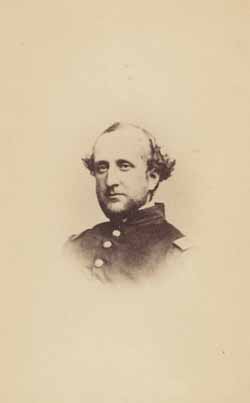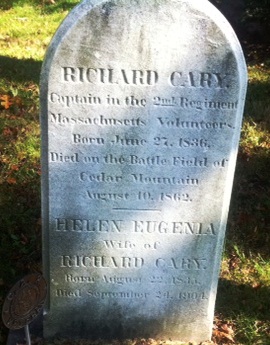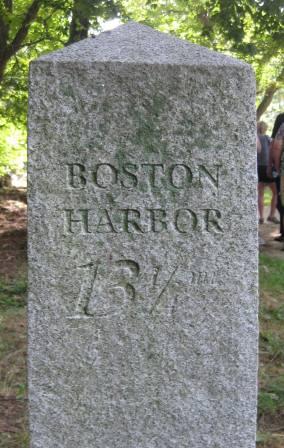By Jim Connolly, Publications
31 August 1862 was a remarkable day in Boston—one full of anxiety and activity. News reached town that day of the Union’s devastating defeat at the Second Battle of Bull Run. The battle, which took place in Virginia from 28 to 30 August, resulted in approximately 15,000 casualties, the vast majority suffered by Union soldiers. Bostonians responded with a diligent relief effort.
Nothing in the historical record captures the mood of such a moment like a good diarist. Caroline Healey Dall (whom I’ve blogged about before) was an excellent one, and her journal, which lives at the MHS, gives us a bracing account.
I heard Mr Clarke preach, yet hardly heard him, for I longed for the service to be over, that I might hurry home to help prepare lint & bandages.
….
No one who was in Boston today—will ever forget it. No one but will be proud to own it as a birth place. The car which I took from Dover St. to Court—was crowded to a crush with women & bundles. Most of them were weeping. “Give way,” said rough men to each other, “those bundles are sacred.” When we got to the Tremont House—a dense crowd had pressed between it & the Hall. All were eagerly gaping for rumors. About the Tremont Temple a semi-circular rope was stretched enclosing several hundreds of cubic feet. At Three Tables, placed in the center & at each end, men took down subscriptions for the freight fund. Within on the side walk immense boxes were being packed. In the building 1800 women sewed all day.
….
In the car that went to Medford every body was bitterly depressed. The women thought—that if we conquered in the end, the life of the Camp would ruin our young men, that they would come home coarse, licentious cruel. I could not stand this, and the end was, that I appealed aloud to the women, in a plea lasting—partly in a conversational way, nearly the whole time we were coming out, as to the moral end of the war. How moved the whole population were we can judge from the fact, that one could hear a pin drop in that rattling car—& there was not a smile at me on man’s or woman’s face.
If the news of the Second Battle of Bull Run and the mad rush to send relief were not cause enough for emotional turmoil, the day held yet another significant—and personal—event for Dall. That morning, her husband, the Unitarian minister Charles Dall, arrived in the ship Panther from Calcutta, where he had been engaged in missionary work since 1855 and where he would live until his death in 1886. This was the first of his four trips home over 31 years. But in the confusion of the day, their paths did not cross.
Willie came out at dusk to tell me, that his father would not get up till tomorrow. I was surprised to find that in the general distress, I had forgotten my private pain, not having thought of the Panther, after thinking of nothing else for months, since I heard she was in the bay.
To learn more about Dall and her materials at the MHS, check out the Caroline Wells Healey Dall Papers 1811-1917: Guide to the Microfilm Edition. We are pleased to work with editor Helen R. Deese to produce the four-volume Selected Journals of Caroline Healey Dall, of which Volume I (1838–1855) is available and Volume II (1855–1866) is in preparation. The excerpts above are taken from the 31 August 1862 entry in volume 25 of Dall’s journals, which covers 24 April 1860 to 23 October 1862, and the full entry will appear in Volume II of Selected Journals.



 Part of the Harbottle Dorr, Jr. Annotated Newspaper project has been to transcribe and encode for presentation and searching at our website his interesting and detailed indexes. In the process, we took special notice of those subject headings that were quirky, weird, and–to our “modern” sensibilities–humorous.
Part of the Harbottle Dorr, Jr. Annotated Newspaper project has been to transcribe and encode for presentation and searching at our website his interesting and detailed indexes. In the process, we took special notice of those subject headings that were quirky, weird, and–to our “modern” sensibilities–humorous. Captain Richard Cary of the Second Massachusetts Volunteer Infantry Regiment, the subject of the
Captain Richard Cary of the Second Massachusetts Volunteer Infantry Regiment, the subject of the 
 attended a dinner of the Sons of Liberty at Liberty Tree Tavern in Dorchester. A
attended a dinner of the Sons of Liberty at Liberty Tree Tavern in Dorchester. A  A newspaper advertisement appearing in the 15 January 1770 issue of the Boston-Gazette, and Country Journal (on page 3) indicates that Dorr sold many kinds of nails and different types of steel in his shop located on Union Street. His inventory included jobents (nails used to fasten hinges and/or other thin iron plates to doors and window frames), deck nails (nails used to fasten planks to the decks of ships), German steel, and English steel. These details help us formulate a picture of Harbottle Dorr–at the counter of his shop, surrounded by hardware, with a newspaper open in front of him, writing in the margins in between transactions with customers.
A newspaper advertisement appearing in the 15 January 1770 issue of the Boston-Gazette, and Country Journal (on page 3) indicates that Dorr sold many kinds of nails and different types of steel in his shop located on Union Street. His inventory included jobents (nails used to fasten hinges and/or other thin iron plates to doors and window frames), deck nails (nails used to fasten planks to the decks of ships), German steel, and English steel. These details help us formulate a picture of Harbottle Dorr–at the counter of his shop, surrounded by hardware, with a newspaper open in front of him, writing in the margins in between transactions with customers.
 By Wednesday participants were ready to take a closer look at the first day of the revolution. We toured many different sites, including Lexington Green, Paul Revere’s capture site, and the North Bridge in Concord, as we
By Wednesday participants were ready to take a closer look at the first day of the revolution. We toured many different sites, including Lexington Green, Paul Revere’s capture site, and the North Bridge in Concord, as we